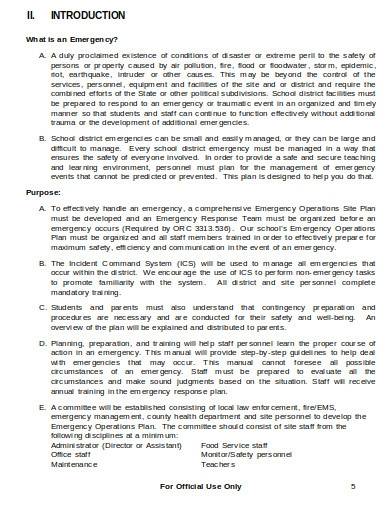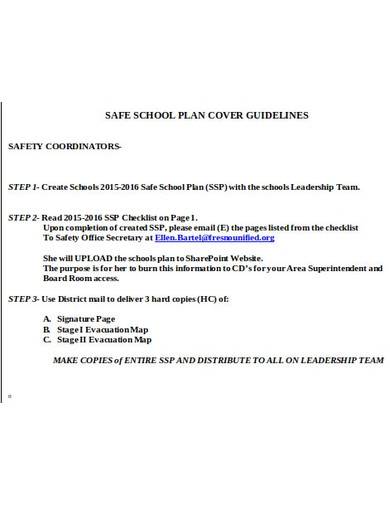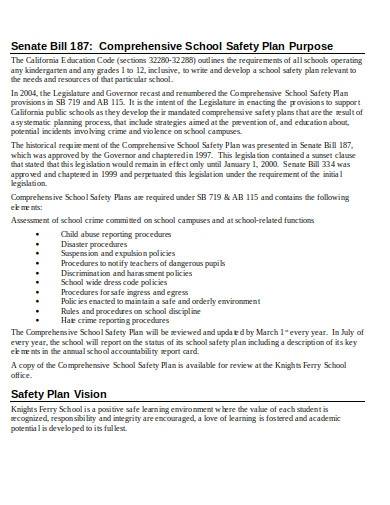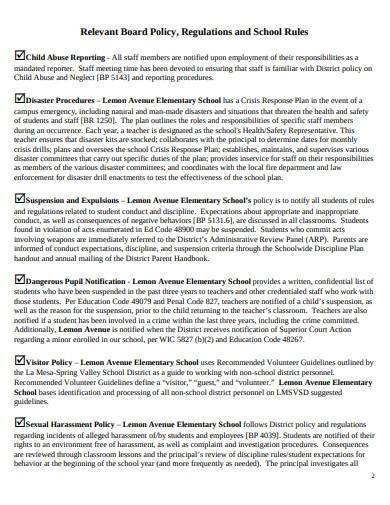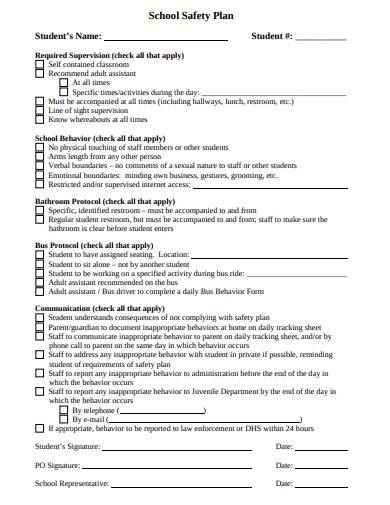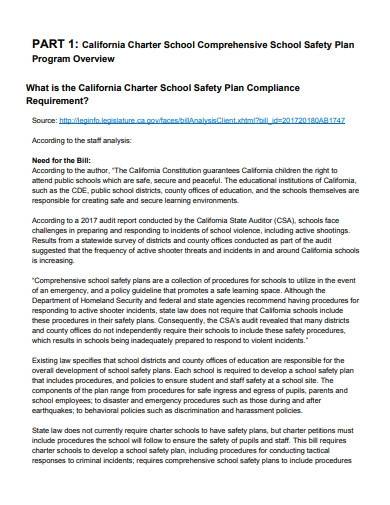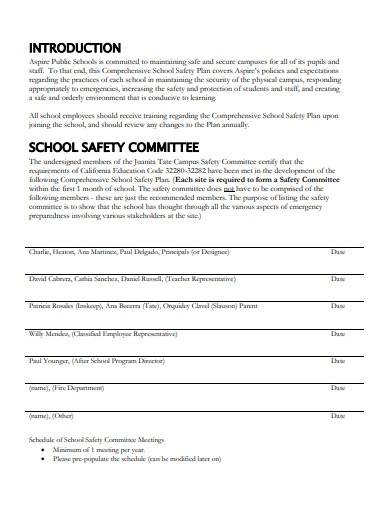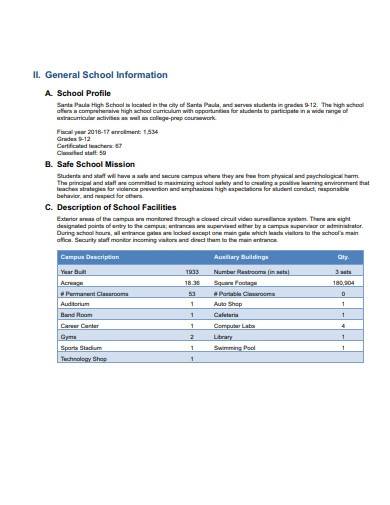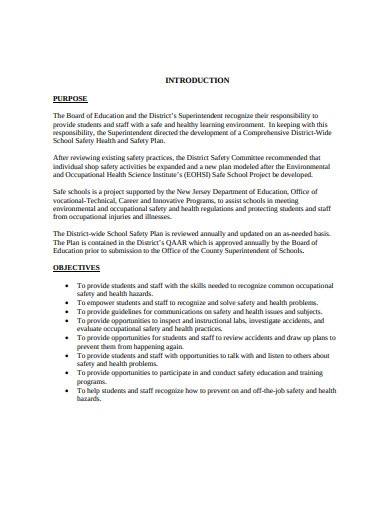Aside from providing quality education, every school aims to prioritize the safety of all its students and staff. No matter how big or small, any educational institution must have a school safety plan ready for any untoward incident or emergency situation. Get to see different school safety plan samples in this article and find out why it’s a must for every school to have one.
FREE 10+School Safety Plan Samples & Templates
1. Safety Plan Template
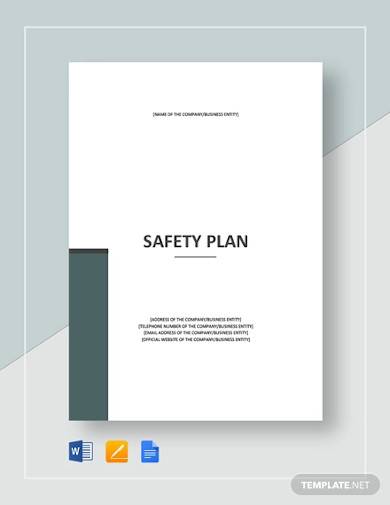
2. Safety Strategy Plan Template
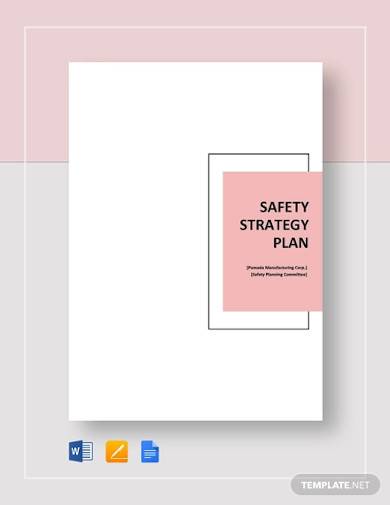
3. School Safety Plan Template
4. Safe School Plan Guidelines
5. Comprehensive School Safety Plan
6. Official School Safety Plan
7. School Safety Plan Form Template
8. Sample Comprehensive School Safety
9. Sample School Safety Plan Template
10. Basic School Safety Plan Template
11. School Safety and Health Plan
What Is a School Safety Plan?
The usual school population mainly consists of the students and the staff. In a school safety plan, the safety of its population is a priority, and it is done by ensuring that the school environment is safe. A health and safety plan is a comprehensive plan that takes into consideration all types of threats and potential hazards that are inside and outside the school’s premises. Safety agents are responsible for implementing the plan and ensures that safety regulations are strictly followed. It is like a standard operating procedure that is used to appropriately respond to emergencies, both natural or man-made.
How To Make a School Safety Plan
A sample safety plan covering the entire school is a big one, and planning for it will not be easy. Making a school safety plan will be a tough journey, so what you can do is ensure that it will all be worth it. Here are a couple of best practices you’ll need to take note of when preparing for a safety plan template.
1. Train All School Staff
A well-trained staff is a school’s best line of defense against any incidents or emergencies. All school administrators, teachers, support staff, and even the students must be trained for any emergency. This allows them to respond accordingly and prevent or minimize harm to anybody.
2. Refine and Evaluate Security Measures in School
Security measures work as a supplement to the school’s safety plan. Examples of security measures include the availability of a functional communication system, visitor restrictions, specific entry and exit hours, remodeling of certain facilities, etc.
3. Conducting Regular Emergency Drills
An implementation plan is an essential part of any plan. And an emergency drill is an effective method of evaluating if both the safety plan and training are effective. Emergency drills also help buildings and establishments earn safety certificates from authorized public safety officials.
4. Build Relations with Public Safety Officials
A school’s safety plan can be made better with the actual help from public safety officials. That is why it is a good practice to build good relations with them. Administrators must also keep in touch with them when making and updating their school safety plans.
5. Regularly Update the Safety Plan
We keep on finding new and improved ways of preventing threats and harms, including how to respond to emergencies. That is why a school’s safety plan must also be regularly updated. You can never tell when something bad will happen, so it’s best to be prepared.
FAQs
What is the purpose of a school safety plan?
A school safety plan is created to ensure that a safe environment for students and at the same time, support academic achievements. Every school must have a clear safety plan prepared for different incidents or emergencies. Although one of the goals of the plan is emergency preparedness, its other purpose is to prevent the occurrence of accidents or to minimize instances of such occasions.
What should be included in a school safety plan?
Elementary schools, high schools, and colleges follow a specific school safety criteria. Some of the details in a school safety plan may vary, but they’ll definitely include the following information:
- Safety awareness lecture/discussion
- School environment safety guidelines
- Student safety measures
- Emergency preparedness drills (earthquake drill, fire drills, evacuation drills, etc.)
- Prevention/mitigation plan
- School emergency information hotlines
- School security plan
- School evacuation plan
- Emergency response action plan
- Emergency checklist
- Family reunification plan
- Incident tracking sheets
- Recovery plan
What do school safety agents do?
School safety agents ensure the safety and security of both the students and the faculty inside the school premises. They also patrol areas surrounding the school buildings and outside the premises. School safety agents also verify the identity of visitors before escorting them to their school destination. It’s a pretty decent civilian job with responsibilities that are similar to police officers.
What safety rules should be implemented in school?
A school safety plan is not complete without the rules. Rules help regulate the activities that students and staff can do within the school premises. Safety rules provide a clear list of acceptable and unacceptable acts inside the school. Here are some of the safety rules that every school must implement:
- No running in halls and stairways
- No pushing
- Hold on to the handrail when going up and down the stairs
- No jumping on the stairs
- Classroom isles should be kept clear
- Pay attention to signboards or warning signs
- Get authorization/supervision when using equipment
- Do not enter unauthorized places
- Wear safety equipment when necessary (laboratory gown, goggles, gloves, boots, face mask, etc.)
- Report damaged equipment as soon as possible
- Use emergency exits when necessary
- Always follow school rules
A school safety plan contains a lot of other safety plans that are specifically created to keep the students and the staff safe from all forms of threats and harm. You can find good reference materials from the different safety plan samples displayed above.
Related Posts
FREE 10+ Lesson Plan Outline Samples in MS Word PDF
FREE 7+ Sample Seminar Planning Templates in PDF MS Word
FREE 38+ Example of Action Plans Samples in MS Word PDF
FREE 38+ Action Plan Templates in MS Word PDF | Excel
FREE 10+ Traffic Management Plan Samples in PDF DOC
FREE 10+ Sample Math Lesson Plan Templates in PDF MS Word
FREE 30+ Action Plan Format Samples in MS Word PDF
FREE 9+ Sample Lesson Plan Templates in MS Word PDF
FREE 9+ Sample Curriculum Planning Templates in PDF MS Word
FREE 35+ Sample Action Plan Templates in MS Word
FREE 11+ Security Operational Plan Samples & Templates in PDF ...
FREE 9+ Sample Attendance Planners in PDF MS Word
FREE 43+ Sample Work Plan Templates in PDF MS Word | Google ...
FREE 10+ Sample Lesson Plan Templates in MS Word
FREE 8+ Sample Behavior Management Plan Templates in MS ...

